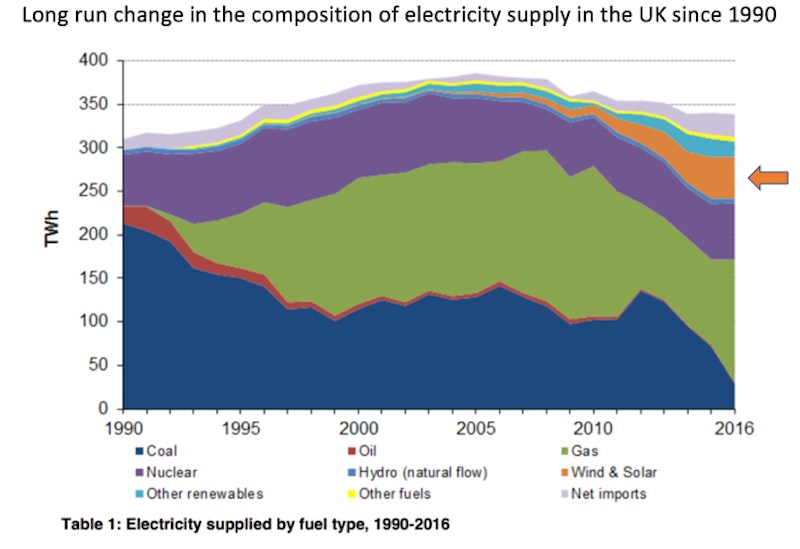Topic Videos
Renewable Energy (Revision Webinar)
- Level:
- AS, A-Level, IB
- Board:
- AQA, Edexcel, OCR, IB, Eduqas, WJEC
Last updated 12 Jun 2018
Here is a revision video from our revision webinar which takes a synoptic perspective on the renewable energy industry. Some additional study notes are also provided below.
Introduction
Britain generated more electricity from renewable and nuclear energy in 2017 than from gas and coal, marking the first year that low-carbon resources have met most of the UK's power needs. In this revision webinar we look at some of the synoptic aspects of the growth of renewable energy with particular reference to the UK but also linking to aspects of development economics.
Rarely a day goes by without a cluster of news reports on the fast-changing renewable industries. For many energy economists, 2017 marked a significant year in the drive towards cleaner (low-carbon) energy and a lot of the new investment into renewables is happening in developing/emerging countries. Could this have transformation effects on the growth and development prospects for many nations?

Renewables on the rise
Are we close to or at the tipping point where renewable energy become as cost-effective as gas and coal? To what extent should the UK government continue to offer subsidies for renewable energies? Can the renewable sector become commercially viable without subsidy? Is there a case for a carbon tax to accelerate the process towards clean energy?
According to Bloomberg New Energy Finance: “Renewable energy sources are set to represent almost three quarters of the $10.2 trillion the world will invest in new power generating technology until 2040, thanks to rapidly falling costs for solar and wind power, and a growing role for batteries, including electric vehicle batteries, in balancing supply and demand.”

What is significant is the rate at which new energy sources are growing. In the last two years the annual growth of renewable energy output is close to 10 per cent. The boom in renewable subsidies helps explain – over 140 countries now support their renewable energy sectors. As economies of scale take hold, the increasing renewable capacity becomes more commercially viable – battery technology is set to advance rapidly and they are capable of storing a lot of renewable energy.
Objectives of UK energy policy
The objectives of energy policy are to ensure a secure and affordable supply of power. A third objective—the de-carbonisation of the power supply—was added in the 21st century as governments adopted carbon emissions targets
The generation of electricity from fossil fuels is (at present) cheaper than renewable sources. To reduce carbon emissions, governments have subsidised renewables, passing on the cost to consumers in their electricity bills.
With Hinkley Point C, the Government, in pursuit of de-carbonisation targets, is guaranteeing subsidies which could commit future generations to inflated electricity prices.
Some renewable sources of energy do not deliver a consistent supply of electricity. Their generation varies with the weather so as dependence on them has grown, so has the need for reliable back-up generation to ensure that the lights do not go out. Ensuring this back-up is available has added to consumers’ bills.
Source: The Price of Power, Reforming the UK Energy Market (House of Lords Report, published February 2017)
First objective: De-carbonisation objective
- Objective is a target for emissions reduction by 2050
- This means seeking the lowest cost of energy consistent with achieving de-carbonization
- Question becomes what is the most efficient policy intervention to achieve this objective?
- Most economists favour a carbon tax whose price would move in order to change the relative price of fossil fuels compared to renewables
Second objective: Electricity secure supply achieved at reasonable cost
This requires the UK to have enough electricity capacity – long run challenge is to invest enough to meet projected demand for energy.
Energy policy and fuel bills
Affordability is a key issue in energy policy especially the impact of fuel bills on the real living standards of families. The average fuel bill for families rose significantly between 2004 and 2014 but has dropped again since. A sizeable proportion of the fuel bill for an average family in the UK now includes a contribution towards the cost of renewable subsidies. As renewable energy increases capacity and lowers unit costs, the subsidy element ought to decline.
But there are also big legacy costs involved with the draw down of fossil-fuel power generation and long term commitments (including a guaranteed strike price) for the next generation of nuclear energy e.g. at Hinkley Point.
Can renewable energy become affordable for families on average or below average incomes? That would be a game-changer especially when families create and store their own energy.
You might also like
Finite and Renewable Resources
Study Notes
Solar industry attacks UK energy policy
18th October 2015
How India is embracing solar power
9th May 2017
Consumers are paying too much for energy
27th October 2017
Scottish government launches prize to drive innovation in tidal power
10th February 2019
Resource Scarcity
Topic Videos

Economic Development - South Africa Turns to Solar to stop Power Cuts
29th November 2022

Renewables - Could floating solar farms survive out at sea?
11th January 2023